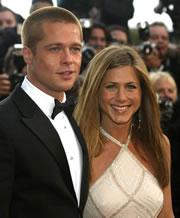 Snaps of Aniston made a single neuron in one subject’s brain light up© Photo/Lionel Cironneau
Snaps of Aniston made a single neuron in one subject’s brain light up© Photo/Lionel CironneauIs a single cell in your brain devoted to Jennifer Aniston or Bill Clinton? Maybe so, according to new research.
A recent experiment showed that single neurons in people's brains react to the faces of specific people. Researchers see the findings as evidence that our brains use fewer cells to decode a given image than previously thought.
The subject of visual processing has sparked much scientific speculation in the past. Exactly how our brains extract meaning from an image remains unclear. At one end of the spectrum of possibilities, a network of cells would process various bits of information in a scene and piece it all together to form an understandable picture.
At the other extreme, the brain would contain a separate neuron to recognize each and every object in the world. Neurobiologist Jerome Lettvin coined the term 'grandmother cell' to parody this view, as it would mean that the brain contains a specific cell to recognize one's own grandmother.
Very few experts believe that grandmother cells exist. But that did not dissuade Rodrigo Quian Quiroga of the California Institute of Technology in Pasadena and his colleagues from investigating single neurons in the brain, to find out how devoted they might be to single people or objects.
Fired up
“In this case it almost seems to be a cell that responds the concept of Halle Berry as it were. But nobody's saying that it's a grandmother cell.”
Martin Tovee
University of Newcastle upon Tyne, UK
The study involved eight patients suffering from epilepsy, all of whom had been temporarily implanted with devices to monitor brain-cell activity as part of their treatment. Quian Quiroga and colleagues took advantage of this opportunity to monitor the firing behaviour of their neurons.
Using a laptop, they presented the subjects with a series of one-second snapshots of celebrities, animals, objects and landmark buildings. Each person was shown a total of almost 2,000 pictures; in each sitting they saw about 90 pictures showing roughly a dozen distinct items.
The recordings taken as they viewed the photographs revealed just how selective cells within the medial temporal lobe - located deep inside the brain- can be. For example, a neuron of one patient responded almost solely to different pictures of Bill Clinton.
The researchers say that these types of cell are involved in sophisticated aspects of visual processing to identify a person, for example, rather than just a simple shape.
Acting on cue
Various pictures of Jennifer Aniston elicited a response in a single neuron inside the medial temporal lobe of another patient. Interestingly, images of her with her former husband Brad Pitt did not sway this cell, the authors of the paper report. Their findings appear this week in the journal Nature1.
ADVERTISEMENT
Quian Quiroga also found that a lone neuron in one subject responded selectively to various pictures of the actress Halle Berry - as well as drawings of her and her name written down. Other cells were found to respond to images of characters in The Simpsons or members of The Beatles.
The team thinks that these brain cells probably respond to a range of different items, but that this limited study didn't include all the various pictures that might make a particular cell light up.
Despite appearing to find a 'Halle Berry cell', notes Martin Tovee, a neuroscientist at the University of Newcastle upon Tyne, UK, who has conducted similar research in monkeys, "nobody's saying that it's a grandmother cell".
Nevertheless, the researchers say the results hint that we might use fewer brain cells to recognize familiar objects than previously thought.
University of Newcastle upon Tyne, UK
